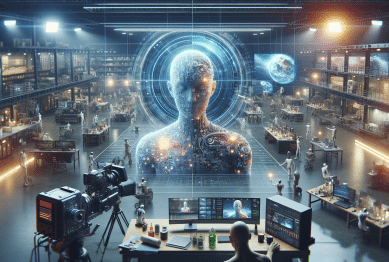Artificial intelligence is shaping complex decision-making in ways many haven’t imagined. Explore the realities behind AI, its ethical dilemmas, machine learning basics, and why understanding bias is crucial if you want to know whether AI can really be trusted with your most important choices.
Understanding Artificial Intelligence in Everyday Life
Artificial intelligence is no longer a distant concept reserved for science fiction. It’s here, woven into daily routines. From voice assistants guiding a recipe to algorithms curating social media feeds, AI shapes experiences more than you may realize. Consumer technology giants rely on deep learning and advanced analytics to deliver personalized recommendations, plan routes, and even monitor health signals through smart devices. Machine learning, a pivotal part of this technology, learns from data patterns to make predictions and decisions with speed and accuracy. Its influence continues to grow as more devices and services integrate learning systems, making these innovations nearly invisible but ever-present.
But artificial intelligence does far more than handle daily convenience. It impacts critical sectors like healthcare, finance, transportation, and public safety. Hospitals use AI to assist with diagnostic imaging, helping specialists identify problems more quickly and, in some cases, with greater accuracy than before. Financial institutions deploy risk assessment algorithms to flag suspicious transactions, while smart cities rely on real-time data from AI to optimize traffic flows and manage public resources. Such advancements raise profound questions: as artificial intelligence makes more decisions for people, how much should society rely on it, and what are the potential consequences of that reliance?
Everyday interactions with artificial intelligence reflect larger, global trends. As countries and major organizations continue to invest in research and development of new technologies, the scope and complexity of AI applications expand. Policymakers and thought leaders must grapple with balancing innovation, accessibility, and oversight. As automated systems take on greater roles in shaping the trajectory of communities, understanding where and how AI fits into your life is a critical first step. Only through awareness can people begin to make informed choices about the role of technology—especially when the stakes go beyond convenience to affect safety, fairness, and well-being.
Machine Learning and the Evolution of Automated Decisions
Machine learning is at the core of contemporary AI advancements. Unlike traditional software built on rules written by programmers, machine learning models adapt based on thousands—or millions—of data points. Instead of being explicitly programmed to solve every problem, these systems analyze huge datasets to find patterns and correlations. When banks use machine learning for loan approval, for instance, they’re evaluating a complex mix of financial habits, history, and social trends. The result is faster, more efficient decisions across many industries. This powerful capability invites excitement but also caution: the sheer scale of data used introduces new challenges in transparency and accountability.
The growth in computational power has accelerated breakthroughs in deep learning, a subset of machine learning that mimics how the human brain processes information. Deep neural networks power applications from face recognition to language translation, yielding remarkable improvements year after year. As businesses and governments embrace these tools, the temptation to automate higher-stakes decisions grows. For example, in healthcare, AI might suggest treatment pathways after reviewing vast medical research, while law enforcement may use predictive analytics for resource allocation. However, relying on algorithms for life-altering choices introduces novel risks: mistaken outputs, data errors, or blind spots can cascade rapidly unless closely monitored.
Automated systems offer incredible speed and efficiency that humans cannot match. Yet, even the most advanced machine learning solutions still need regular oversight. Learning algorithms can drift from intended behaviors, especially when trained on evolving or imperfect data. Ensuring these systems remain aligned with ethical standards is critical. Industry practitioners often stress the importance of rigorous validation, unbiased input data, and continuous monitoring to reduce unintended harm. As more organizations implement AI-driven processes, questions surrounding algorithmic governance, auditability, and user trust move to the forefront, prompting ongoing public debate and regulatory review.
AI Bias and Fairness: Challenges Hidden Beneath the Surface
Bias in artificial intelligence is a growing concern affecting decisions across sectors. Algorithms learn from historical data, which often reflects societal inequalities. When unchecked, these biases can become embedded in the models, perpetuating discrimination instead of delivering impartial results. For instance, hiring platforms powered by machine learning may inadvertently favor candidates from certain backgrounds if trained on biased historical resumes. Similarly, facial recognition software can show disparities in accuracy across different ethnicities. The call for AI fairness is not just technical—it’s a matter of social justice and equity, impacting how opportunities and resources are distributed.
Detecting and mitigating bias in AI requires a multidisciplinary approach. Developers must scrutinize training data with a critical eye, looking for hidden patterns that might produce unethical outcomes. Input from sociologists, legal scholars, and ethicists is essential to design systems that respect diversity, inclusiveness, and equal opportunity. In recent years, responsible AI initiatives have gained traction at technology companies and academic institutions. These guidelines aim to foster transparency and accountability, demanding routine bias testing and open reporting of outcomes. By recognizing that algorithms are not immune to prejudice, organizations can take concrete steps toward more ethical deployment.
Users increasingly expect transparency regarding automated decisions. Governments and civil society groups advocate for algorithmic accountability, especially in sensitive domains such as hiring, lending, and criminal justice. Tools like explainable AI (XAI) allow decision-makers and the public to understand how an algorithm arrived at its conclusion. However, explainability alone may not be enough. Stakeholders need assurance that measures are in place to protect against unfair disadvantage. As the international conversation around AI bias grows, setting and enforcing standards becomes a collective responsibility, ensuring that technology serves rather than hinders social progress.
Ethical Dilemmas and Accountability of Artificial Intelligence
Responsibility for AI-driven decisions is complex. When a machine learning system makes an error, who is accountable—the developers, the organizations deploying the AI, or the technology itself? Such questions fuel heated debates. In fields like autonomous vehicles, even minor errors can lead to major consequences. Some jurisdictions now require auditing of AI systems before critical deployment, emphasizing oversight and documentation. The principle of ethical AI asks not simply whether an outcome is technically possible but whether it aligns with broader values of fairness, safety, and respect for human rights.
Regulators worldwide are addressing ethical AI development by developing new guidelines and frameworks. For example, the European Union’s AI Act focuses on transparency, risk management, and user rights. Industry groups propose voluntary codes of conduct to fill transitional gaps. These efforts recognize that ethical dilemmas cannot always be solved with technical solutions alone—robust governance, interdisciplinary collaboration, and clear accountability mechanisms are needed. Companies with strong AI ethics policies are more likely to earn public trust and avoid reputational or legal risks down the line. Dialogue among technology companies, policymakers, and the public is vital for crafting sustainable solutions.
Accountability measures may include third-party audits, transparent model documentation, and user recourse options. Establishing clear lines of responsibility and chains of command helps manage risk and maintain oversight. Organizations are exploring ways to involve end-users in AI governance, whether through feedback mechanisms or advisory councils. The field remains dynamic. As new challenges surface—such as generative AI producing misleading content—policy and procedure must evolve. Trust in AI requires an ongoing commitment to openness, dialogue, and learning from both successes and failures along the way.
Real-World Case Studies: When AI Decisions Matter Most
Case studies highlight both the promise and pitfalls of artificial intelligence. In medical diagnostics, deep learning has helped radiologists detect breast cancer in imaging scans with higher accuracy, occasionally spotting anomalies missed by experts. However, there have also been cases where AI systems, trained on a narrow patient demographic, failed to generalize across broader populations, leading to misdiagnoses or inadequate recommendations. In criminal justice, risk assessment algorithms have influenced bail and sentencing decisions, yet controversy persists over whether these tools reinforce systemic biases or help reduce human arbitrariness. Each scenario underscores the importance of context, data quality, and human oversight.
Financial services are another area where AI’s impact is visible. Credit scoring algorithms now incorporate alternative data, like utility payments or social media activity, to provide faster credit decisions. While this approach can increase access to credit, it also raises privacy and fairness concerns. Unexpected outcomes—such as certain groups being systematically excluded based on algorithmic predictions—have led regulators to investigate practices and push for greater transparency. The lesson? Even with sophisticated models, unforeseen complexities often emerge, challenging developers to consider the full scope of possible effects and continuously adapt their strategies.
Automated decision-making extends into the public sector, too. Law enforcement agencies use predictive policing tools to inform resource deployment. Cities employ AI-driven systems for resource management and emergency response. Early successes suggest that, when carefully validated, AI can improve efficiency and save lives. But the risks associated with overreliance or poor oversight persist. Each deployment offers valuable insights into what works, what doesn’t, and what safeguards are necessary when the stakes are high. Ongoing real-world trials, academic evaluations, and independent audits all play a role in advancing knowledge and protecting the public interest.
The Future of Trust in AI: Navigating Uncertainty Together
As artificial intelligence systems grow more capable, determining where—and how—to trust them becomes a shared task. No single actor holds all the answers. Governments, industry leaders, and the public must work collaboratively to set standards, share lessons, and address emerging risks. Transparency, open dialogue, and well-designed consultation processes enhance trust and encourage responsible technology development. As new regulations and best practices emerge, the focus must stay on aligning technology outcomes with the values and interests of society as a whole.
Education is central to building resilience in an AI-driven world. Understanding core concepts like algorithmic accountability, explainability, and fairness empowers users to engage meaningfully with automated systems. Training for developers, policymakers, and the public will be increasingly vital. By fostering a culture of critical inquiry and openness, communities can better anticipate challenges and identify possible solutions. As artificial intelligence continues to evolve, so too must collective strategies for oversight and stewardship.
The journey toward trustworthy AI is ongoing. Mistakes and setbacks are part of progress, prompting improvement and reflection. As new technologies emerge, adapting governance frameworks and ethical principles will require flexibility and vigilance. Ultimately, trust in artificial intelligence depends not on eliminating risk, but on managing it transparently. When deployed thoughtfully, AI can unlock tremendous benefits—delivering innovations that shape society for the better, while keeping fundamental values at the core of every decision.
References
1. European Commission. (n.d.). Ethics guidelines for trustworthy AI. Retrieved from https://digital-strategy.ec.europa.eu/en/policies/ethics-guidelines-trustworthy-ai
2. U.S. National Institute of Standards and Technology. (n.d.). Artificial Intelligence Risk Management Framework (AI RMF 1.0). Retrieved from https://www.nist.gov/itl/ai-risk-management-framework
3. Royal Society. (n.d.). Machine learning: the power and limits of algorithms. Retrieved from https://royalsociety.org/topics-policy/projects/machine-learning/
4. American Civil Liberties Union. (n.d.). The pitfalls of AI decision-making. Retrieved from https://www.aclu.org/issues/privacy-technology/surveillance-technologies/pitfalls-ai-decision-making
5. Stanford University Institute for Human-Centered Artificial Intelligence. (n.d.). AI and society. Retrieved from https://hai.stanford.edu/research/ai-and-society
6. Brookings Institution. (n.d.). Algorithmic bias detection and mitigation: Best practices and policies to reduce consumer harms. Retrieved from https://www.brookings.edu/research/algorithmic-bias-detection-and-mitigation-best-practices-and-policies-to-reduce-consumer-harms/









